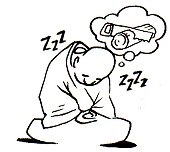 |
| illustration by M.Zittel |
Many people have issues around sleep. They may get sleepy when they want to be alert (i.e., during meditation practice) or they may have difficulty falling asleep or staying asleep when they want to (i.e., they have insomnia). Sadly, some people have both issues. I plan to address the insomnia piece in a future blogpost. In this blog, I’d like to offer some practical suggestions around the sleepiness piece.
In the Buddhist tradition, there’s a term that translates into English as “sinking.” (In Japanese, it’s called konjin; in Tibetan it’s called chingwa). This term is quite generic, covering the whole range from subtle fuzziness to complete loss of consciousness. The remarks below are applicable to any point on that range.
There’s an objective side to sleepiness and there’s a sensory side to sleepiness.
The objective side involves two things:
- One’s body posture.
- One’s degree of alertness.
The sensory side also involves two things:
- Pleasant states associated with being sleepy.
- Unpleasant states associated with being sleepy.
That gives a total of four components (two objective and two sensory). The trick in dealing with sleepiness is to work optimally with these four components.
On the objective side:
- With regards to posture: one has to fight over and over to re-establish good posture:
- Straighten the spine.
- Force the eyes open if need be.
- Stand up.
- Etc., etc.
- With regards to alertness, one has to fight against its loss:
- The posture piece can help;
- Forcing yourself to speak labels out loud can also help;
- But basically, it’s a function of time and practice, and will.
On the sensory side:
- With regards to the unpleasant sensory side of the experience, try to accept the uncomfortable sensations of sleepiness in the body: Greet them with equanimity until they turn into a flowing energy. You may have had the experience of a pain or an itch breaking up into flow. It’s hard to believe, but the same thing can happen with uncomfortable sleepy sensations. You can “watch them to death.” At that point, they turn into a kind of energy that circulates around your body, inflating you with vitality.
- The pleasant sensory aspect of sleepiness are the restful states (See Rest, Hear Rest, and especially Feel Rest in the form of muscle relaxation). Try to notice that sleepiness comes in waves. Each wave of sleepiness carries two things:
- a wave of unconsciousness which we should fight with, and
- a wave of restfulness which we can detect and enjoy.
Here’s an example of what I mean. Try to notice that at the onset of each wave of sleepiness, there is a tendency for the whole body to relax (that’s why people lurch). But if you tangibly detect that relaxation, you won’t lurch—you’ll just drop a notch into deeper repose. So each new wave of sleepiness becomes a new wave of settledness. Wave by wave, second by second, you drop deeper and deeper. It’s attentional jujitsu. Objective unconsciousness is your opponent. With this trick, you use his weight to your advantage!
Detecting the pleasure of sleepiness clearly and enjoying it without craving allows you to re-engineer the experience of sleepiness into the experience of jhānic absorption.